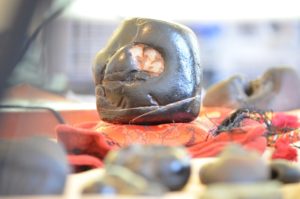Clothing is an important part of fieldwork. And by this, I don’t just mean planning for inclement weather or deciding which pants are more likely to hold up through months in the jungle. For many anthropologists, clothing choices in the field must also often reflect the cultural norms and mores of the people with which we could be spending up to a year or more living and working with. For this reason, many anthropologists in the field tend to adopt local dress codes, both as a method of participating closely with and respecting cultural attitudes (especially certain attitudes regarding religion or gender) and as a way of indicating our insider/outsider researcher status (as opposed mainly to ‘tourist’) among groups of people who may otherwise find our long-term presence strange.
During my first fieldwork project in West Bengal in northern India, my decision to wear the Indian sari fell along these lines. In response to local concerns regarding Western clothing in an especially holy pilgrimage site for Hindus and concerns about certain styles of Western clothing popular among urban women, I wore a full sari each day without question. I also found it to be an important learning experience. The rapport I quickly built with the elderly women who taught me to properly tie the garment paid off in other ways as well, particularly in invitations to attend religious rituals or in invitations to household meals and other events. Additionally, my willingness to wear saris was also taken as an indication of my openness to other kinds of cultural participation, such as learning religious mantras or taking instruction on how to care for a material deities placed in people’s homes.
But as I began to travel outside the pilgrimage temple village into the surrounding rural areas, I started to run into an interesting and unexpected problem. To many villagers not directly involved in pilgrimage activites, a young white woman in a sari had another meaning: as a statement of religious affiliation. In this case, my country of origin combined with my choice to dress in the traditional sari meant, to them, that I was a devotee of ISKCON (International Society of Krishna Consciousness or, as they are known in the United States, the Hare Krishnas). And as a presumed devotee of ISKCON, many were uninterested in speaking with me. However, this was not a statement on their parts that indicated that they particularly disliked ISKCON but more that they assumed I had a conversion agenda and that I didn’t actually know anything about Vaishnava practice more prevalent in village contexts (I won’t go into the details here but suffice it to say that Bengali folk Vaishnavism and ISKCON Vaishnavism have a number of significant differences). They also assumed I didn’t know the local language, since international devotees on pilgrimage rarely do.
Shortly after my initial experiences then, I decided to modify my daily clothing to appear somewhat more Western (though not overly so). I started dressing in kameez shirts and loose, linen, pants, and if I wore a dupatta (a kind of long scarf) I stopped using it to cover my head. I still kept my hair up, however, and still wore hand-dyed Bengali patterns and fabrics whenever possible. The results were immediate. In the surrounding villages, I was met with an equal amount of hospitality as before, but this time with greater interest in what my work was about and did I want to talk more, where was I coming from, and how had I learned to speak so much Hindi in such a short time?
Now, currently working in Nepal (though on similar topics of religion, pilgrimage, and sacred objects), I’ve maintained this sartorial strategy. I have neither adopted the Indians saris of Hindu pilgrims to the region (as that would actually mark me to the local peoples as “Hindu”) nor do I dress in the styles typical of Nepali women (as styles here are highly varied and often have connotations of ethnic identity). However, I do incorporate both Indian and Nepali styles mixed in with the sturdy trekking boots and canvas pants vital for mobility in the high Himalayas. This way, I remain clearly a cultural outsider (neither Hindu nor Buddhist, not Indian, not Tibetan, and not Nepali), but to the interest of many, I am also clearly not just another Western tourist here on holiday. My use of both Hindi and Nepali in social situations and my habit of taking my meals with the local families (rather than in the dining halls with other trekkers and tourists) also helps. For example, in one particularly amusing exchange, I once had to explain to a guesthouse owner that the other “white people” in the dining hall he kept encouraging me to socialize with were from Belgium and that I spoke neither French nor Dutch. I did, however, speak Hindi and therefore I actually could socialize with the Indian and Nepali pilgrims and families separated out in the sitting room.
In the end, the decision to wear or not to wear the typical or traditional clothing of the peoples of one’s study region is based on a large number of factors both internal to the anthropologist and external to the world they are participating in. But regardless of what they choose (or at what point they choose it), we end up learning a great deal about the people we work with sometimes just by the way they talk about our clothes. And fair warning, this doesn’t end when we come home either…




